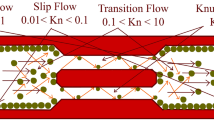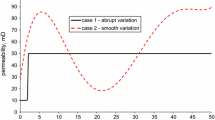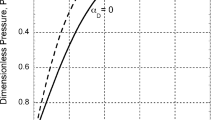Abstract
The one-dimensional diffusion equation was solved to understand the pressure and flow behaviors along a cylindrical rock specimen for experimental boundary conditions of constant upstream pressure and constant downstream storage. The solution consists of a time-constant asymptotic part and a transient part that is a negative exponential function of time. This means that the transient flow exponentially decays with time and is eventually followed by a steady-state condition. For a given rock sample, the transient stage is shortest when the downstream storage is minimized. For this boundary condition, a simple equation was derived from the analytic solution to determine the hydraulic permeability from the initial flow rate during the transient stage. The specific storage of a rock sample can be obtained simply from the total flow into the sample during the entire transient stage if there is no downstream storage. In theory, both of these hydraulic properties could be obtained simultaneously from transient-flow stage measurements without a complicated curve fitting or inversion process. Sensitivity analysis showed that the derived permeability is more reliable for lower-permeability rock samples. In conclusion, the constant head method with no downstream storage might be more applicable to extremely low-permeability rocks if the upstream flow rate is measured precisely upstream.






Similar content being viewed by others
References
Bernabé, Y., Mok, U., and Evans, B. (2006), A note on the oscillating flow method for measuring rock permeability, Int. J. Rock Mech. Min. Sci. and Geomech. Abstr. 43, 311–316.
Brace, W.F., Walsh, J.B., and Frangos, W.T. (1968), Permeability of granite under high pressure, J. Geophys. Res. 73, 2225–2236.
Carslaw, H.S. and Jaeger, J.C., Conduction of heat in solids, (Oxford University Press, New York 1959).
Craig, R.F., Soil mechanics (Chapman and Hall, London 2004).
Fischer, G.J., The determination of permeability and storage capacity: Pore pressure oscillation method, In Fault mechanics and transport properties of rocks (eds. Evans, B. and Wong, T.-F.) (Academic Press, London 1992) pp. 187–211.
Green, D.H. and Wang, H.F. (1986), Fluid pressure response to undrained compression in saturated sedimentary rock, Geophysics 51, 948–956.
Hart, D.J. and Wang, H.F. (1995), A single test method for determination of poroelastic constants and flow parameters in rocks with low hydraulic conductivities, Int. J. Rock Mech. Min. Sci. 38, 577–583.
Hsieh, P.A., Tracy, J.V., Neuzil, C.E., Bredehoeft, J.D., and Silliman, S.E. (1981), A transient laboratory method for determining the hydraulic properties of tight rocks - I. Theory, Int. J. Rock Mech. Min. Sci. Geomech. Abstr. 18, 245–252.
Iverson, R.M., Reid, M.E., Iverson, N.R., LaHusen, R.G., Logan, M., Mann, J.E., and Brien, D.L. (2000), Acute sensitivity of landslide rate to initial soil porosity, Science 290, 513–516.
Knopman, D.S. and Voss, C.I. (1987), Behavior of sensitivities in the one-dimensional advection-dispersion equation: Implication for parameter estimation and sampling design, Water Resour. Res. 23, 253–72.
Kreyszig, E., Advanced Engineering Mathematics (John Wiley & Sons, New York 1983).
Malinarič, S. and Ďuríšek, P., Sensitivity coefficients analysis, In Proceedings of Thermophysics (2004) pp. 18–24.
Marshall, S.I. (2009), Nonlinear pressure diffusion in flow of compressible liquids through porous media, Transp. Porous Med. 77, 431–446.
Morin, R.H. and Olsen, H.W. (1987), Theoretical analysis of the transient pressure response from a constant flow rate hydraulic conductivity test, Water Resour. Res. 23, 1461–1470.
Neuman, S.P. (1977), Theoretical derivation of Darcy’s law, Acta Mechanica 25, 153–170.
Olsen, H.W., Nichols, R.W., and Rice, T.L. (1985), Low gradient permeability measurements in a triaxial system, Geotechnique 35, 145–157.
Parotidis, M., Rothert, E., and Shapiro, S.A. (2003), Pore-pressure diffusion: A possible triggering mechanism for the earthquake swarms 2000 in Vogtland/NW-Bohemia, central Europe, Geophys. Res. Letter 30, 2075, doi:10.1029/2003GL018110.
Reid, M.E. (1994), A pore-pressure diffusion model for estimating landslide-inducing rainfall, J. Geol. 102, 709–717.
Shapiro, S.A., Patzig, R., Rothert, E., and Rindschwentner, J. (2003), Triggering of seismicity by pore pressure perturbations: permeability related signatures of the phenomenon, Pure Appl. Geophys. 160, 1051–1066.
Song. I., Elphick, S.C., Main, I.G., Ngwenya, B.T., Odling, N.W., and Smyth, N.F. (2004), One-dimensional fluid diffusion induced by constant-rate flow injection: theoretical analysis and application to the determination of fluid permeability and specific storage of a cored rock sample, J. Geophys. Res. 109, B05207, doi:10.1029/2003JB002395.
Song, I. and Renner, J. (2006), Linear pressurization method for determining hydraulic permeability and specific storage of a rock sample, Geophys. J. Int. 164, 685–696.
Song, I. and Renner, J. (2007), Analysis of oscillatory fluid flow through rock samples, Geophys. J. Int. 170, 195–204.
Song, I., Renner, J. (2008), Hydromechanical properties of Fontainebleau sandstone: experimental determination and micromechanical modeling, J. Geophys. Res. 113, B09211, doi:10.1029/2007JB005055.
Song, I., Rathbun, A.P., and Saffer, D. (2013), Uncertainty analysis for the determination of permeability and specific storage from the pulse-transient technique, Int. J. Rock Mech. And Min. Sci. 64, 105–111.
Talwani, P. and Acree, S. (1984), Pore pressure diffusion and the mechanism of reservoir-induced seismicity, Pure Appl. Geophys. 122, 948–964.
Tokunaga, T. and Kameya, H. (2003), Determination of specific storage of a porous material from flow pump experiments: theoretical analysis and experimental evaluation, Int. J. Rock Mech. Min. Sci. 40, 739–745.
Trimmer, D., Bonner, B., Heard, C., and Duba, A. (1980), Effect of pressure and stress on water transport in intact and fractured gabbro and granite, J. Geophys. Res. 85, 7059–7071.
Trimmer, D. (1981), Design criteria for laboratory measurements of low permeability rocks, Geophys. Res. Letters 8,973–975.
Trimmer, D. (1982), Laboratory measurements of ultra low permeability of geologic materials, Review of Scientific Instruments 53, 1246–1254.
Wang, H.F. and Hart, D.J. (1993), Experimental error for permeability and specific storage from pulse decay measurements, Int. J. Rock Mech. and Mining Science. 30, 1173–1176.
Wang, H.F., Theory of linear poroelasticity with applications to geomechanics and hydrogeology (Princeton University Press, Oxford 2000).
Zoback, M.D. and Byerlee, J.D. (1975), The effect of microcrack dilatancy on the permeability of Westerly granite, J. Geophys. Res. 80, 752–755.
Acknowledgments
This work was supported by the Basic Research Program of Korea Institute of Geoscience and Mineral Resources (KIGAM). This work was also supported by the Korea CCS R&D Center (KCRC) grant funded by the Korea Government (Ministry of Science, ICT & Future Planning) (No. 2014M1A8A1049287).
Author information
Authors and Affiliations
Corresponding author
Appendix 1: Particular Solution of the 1-D Differential Equation
Appendix 1: Particular Solution of the 1-D Differential Equation
A procedure for solving the one-dimensional diffusion equation is briefly described here. Applying the Laplace transform to the partial differential Eq. (2) yields
Equation (25) with the initial condition, Eq. (3), can be expressed in the form of an ordinary differential equation
where \(\overline{p}\) is the Laplace transform of p. The general solution of Eq. (26) is
Taking the Laplace transforms of the boundary conditions, Eqs. (4) and (5), we can determine C 1 and C 2 in Eq. (27), so that Eq. (27) becomes
The inverse Laplace transform of \(\overline{p}\) is
where γ has to be sufficiently large that all the singularities of \(\overline{p} (s)\) lie to the left of the line (γ − i∞, γ + i∞). The contour integral (Eq. (29)) can then be evaluated by computing the contour to the left and summing residues. From the residue theorem, Eq. (29) is rewritten as
where s m are poles of the integrand, and Re s(s m ) are the associated residues. In Eq. (29), the integrand, \(e^{st} \overline{p} (s)\), has a simple pole at s = 0:
Taking the first two terms in the Taylor series of sinhx, coshx, and e st yield
\(\sinh qx = qx + \frac{{q^{3} x^{3} }}{3!},\cosh qx = 1 + \frac{{q^{2} x^{2} }}{2!},\), and e st = 1 + st, respectively. Higher-order terms do not contribute to the pole at s = 0. Now Eq. (28) becomes
The residue at a simple pole of order m > 1 at z = a of a function f (z) is given by Kreyszig (1983, p. 721),
The residue of \(e^{st} \overline{p} (s)\) at s = 0 for m = 2 is
where \(S_{d} \ne \infty\). If \(S_{d} = \infty\) for the boundary condition, Eq. (32) will be
From the same procedure,
In addition, if q is an imaginary the function, multiple poles occur when the denominator in Eq. (28) vanishes; that is,
Because q is imaginary, we can write
where ϕ is a real number. Then, from Eq. (26) it is seen that s is always negative:
Equation (37) can be rewritten by substituting Eq. (38) into Eq. (37):
where \(\delta = \frac{{S_{d} }}{{S_{s} AL}}\) ϕ m are roots of Eq. (40). Substituting q = iϕ and s = −κϕ2, the integrand can be rewritten as
The multiple poles are then determined by the roots ϕ m of Eq. (40). Now \(e^{st} \overline{p} (s)\) is of the form N(s)/D’(s) and the residues are given by
where \(S_{d} \ne \infty\). If \(S_{d} = \infty\), the residues are given by
Because \(\phi_{m}\) are roots of Eq. (40), \(\phi_{m} L = m\pi\) where \(m = 1,{ 2},{ 3}, \ldots\). Then Eq. (43) becomes
The complete equation for p is
When \(S_{d} \ne \infty\), the complete analytic solution of the diffusion equation is
and when \(S_{d} = \infty\),
Rights and permissions
About this article
Cite this article
Song, I. Theoretical Analysis of One-Dimensional Pressure Diffusion from a Constant Upstream Pressure to a Constant Downstream Storage. Pure Appl. Geophys. 173, 1721–1731 (2016). https://doi.org/10.1007/s00024-015-1209-4
Received:
Revised:
Accepted:
Published:
Issue Date:
DOI: https://doi.org/10.1007/s00024-015-1209-4




